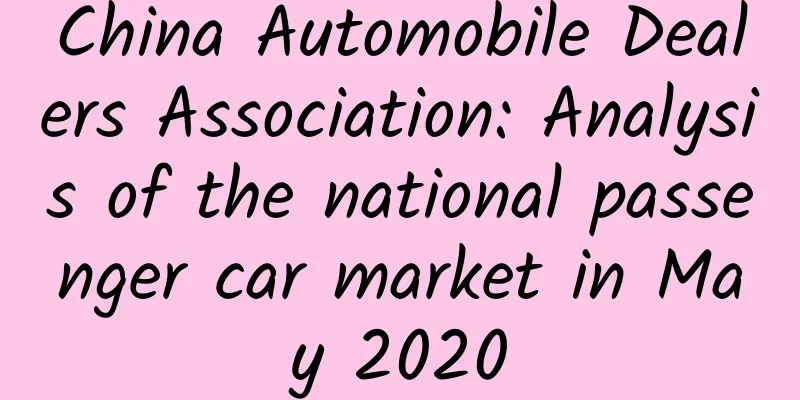|
1.4 National Passenger Car Market Consultants 1. Review of the national passenger car market in May Retail: In May, the passenger car market retail sales reached 1.609 million units, a year-on-year increase of 1.8%. This is also one of the first months since June 2018 that the year-on-year growth rate has returned to positive growth (excluding the National V dumping factor in June 2019). Since the outbreak of the epidemic at the beginning of this year, the growth rate of the auto market from January to May was -20%, -78%, -40%, -3%, and 2%, and the rebound after the epidemic was strong. The recent year-on-year growth rate from April to May has stabilized, which means that the good trend of a V-shaped recovery from the bottom since the epidemic has been confirmed. In May this year, retail sales grew by 12.6% month-on-month from April, while May in previous years was basically the same as April. The stronger month-on-month growth in May this year reflects that the comprehensive policies such as resumption of production and work after the epidemic have guided the market recovery to a good effect, and the rigid demand continued to recover after the epidemic. As the epidemic eases and students in various regions resume classes, the demand for car purchases and replacements continues to be released, driving the continued strength of the auto market. In addition, the gradual implementation of consumption promotion policies in various regions has greatly improved consumer confidence after the epidemic. Luxury car retail sales increased by 28% year-on-year in May, and the demand for high-end replacement purchases due to consumption upgrades has quickly recovered. The overall trend of mainstream joint venture brands and leading independent brands is relatively strong, but the retail differentiation of auto companies is becoming more obvious, and small and medium-sized auto companies are struggling to survive. The retail performance of major manufacturers in May has changed significantly compared with the ranking in the same period. The retail sales of independent manufacturers such as Changan and Hongqi are relatively strong, mainly because the upgrade and replacement effects of independent brand products have been better recognized by the market. From January to May 2020, the national passenger car market had a cumulative retail sales of 6.051 million vehicles, a year-on-year cumulative decrease of 26.0%. The cumulative sales this year fell by 2.16 million vehicles year-on-year, accounting for about 10 percentage points of last year's total retail sales, mainly due to the dual impact of the early Spring Festival and the epidemic. Exports: In May, the customs exported 58,000 vehicles, down 36% from May last year and 45% from April, but the export value fell 12% from the previous month and 8% from the previous year, reflecting the huge market pressure in developing countries. Overseas CKD exports of passenger cars remained the same year-on-year. Production: In May, 1.611 million passenger cars were produced, up 10.2% year-on-year from May 2019 and up 5.8% month-on-month from April. Among them, the production of joint venture brands increased by 10% month-on-month from April. The cumulative production from January to May was 5.711 million units, down 30.0% year-on-year, with a production decrease of 2.45 million units. Wholesale: In May, the manufacturer's wholesale sales volume was 1.643 million vehicles, up 6.3% year-on-year from May last year and up 9.4% month-on-month from April. This is also the first positive growth in wholesale volume in 22 months since July 2018. From January to May, the cumulative wholesale sales volume was 5.963 million vehicles, down 27.8% year-on-year, a decrease of 2.29 million vehicles. Inventory: In May, the manufacturer's inventory decreased by 32,000 units, while the channel inventory increased by 1,000 units. The stable inventory change is mainly due to the fact that dealers have just started to replenish their inventory slightly, and the recovery of retail sales has increased dealers' confidence in building inventory. New energy: In May, the wholesale sales of new energy passenger cars reached 70,200 units, down 25.8% year-on-year and up 19.5% month-on-month from April. Among them, the sales of plug-in hybrid vehicles reached 14,000 units, down 31% year-on-year. The wholesale sales of pure electric vehicles reached 56,000 units, down 27% year-on-year. Tesla ranked first in new energy sales in May, and the performance of wholly-owned and joint venture new energy vehicles was strong. New forces such as Weilai have become an important force in the new energy vehicle market. In May, the wholesale sales of ordinary hybrid passenger cars reached 29,000 units, up 52% year-on-year from May last year. 2. Outlook for the national passenger car market in June There are 21 working days in June, two more than last June, which is conducive to the continued recovery of production and sales of auto companies. In May, the import of auto parts was US$1.9 billion, down 16% from April and 24% from May last year. With the gradual restart of overseas supply chains in May, passenger car production is expected to stabilize in June. June is the last production and import time for light vehicles of National V in the central and western regions, and the time for heavy urban vehicles to implement National VIa standards, which is conducive to the increase in production and sales in June. In particular, the import volume of parallel imported vehicles represented by Tianjin Port is expected to rebound significantly, and is expected to hit a new high this year. Auto shows in various places in June have started normally. Coupled with the continued advancement of local policies to promote consumption, the market in June will break the off-season market rules of previous years and continue to recover. As the country encourages self-employment, more people are considering buying a car to start their own business and make a living, which will also promote the demand in the car market. As the rigid demand and previously suppressed demand from March to May are basically released, coupled with the rapid rise in temperature in June, which is a traditional off-season month, sales will fall. In June, most domestic students have returned to school, the demand for urban families to buy cars for transportation has weakened, and the month-on-month growth momentum of the auto market has weakened. In the first four months of this year, profits in the automotive industry fell by 52%, and corporate performance was severely affected, resulting in a decline in companies' ability to rely on their own profits to subsidize the development of new energy. In June last year, the main regions had entered the panic and strong promotion stage before the implementation of National VI, which pushed the retail base in June last year to an extremely high level, which was not conducive to the year-on-year growth rate of the auto market in June this year. 3. Encouraging car-less families to buy cars is of great significance The main feature of the current auto market is the differentiation between high-end and low-end, and the demand for models below 80,000 yuan is sluggish. Luxury cars grew by 20% year-on-year in May, and domestic brands are under relatively great pressure to perform. This is also a feature that the purchasing power of first-time buyers has not been fully reflected. To promote consumption, we must attract the first-time buyers of new cars. The core of promoting auto consumption is to promote the popularization of private cars, which can have the effect of driving growth. Under the current conditions, most of the key measures to promote automobile consumption in various places are aimed at promoting replacement demand, and there are few policies to promote new purchase demand. The reason is that replacement demand can drive sales growth and second-hand car growth, but it does not drive the total volume much, and local governments are under little pressure to protect the environment and deal with congestion. It can be said that the new car replacement subsidy has not achieved the expected effect in directly improving the entry-level consumption of ordinary people. Even without policy stimulus, the demand for replacement purchases is already very strong, so policies should focus on first-time purchases. Policies such as reducing the purchase tax on small-displacement vehicles have a significant impact on the first-time purchase group. Having a car will expand the scope of life and work for ordinary families. Entry-level consumption in the auto market was still weak in May, so short-term direct market stimulus policy recommendations should still target first-time buyers, especially preferential purchase tax policies for small-displacement vehicles. Policies to encourage consumption among car-free groups are of great significance to expanding the domestic market and promoting sustainable consumption. 4. The consumption tax collection stage is moved back - the tax reform trend is conducive to the healthy development of the real estate and auto markets The CPC Central Committee and the State Council recently issued the "Opinions on Accelerating the Improvement of the Socialist Market Economic System in the New Era". The "Opinions" pointed out that it is necessary to accelerate the establishment of a modern fiscal and taxation system and steadily promote the legislation of real estate tax. This is a long-term trend positive for auto market consumption, and we must strengthen our confidence in the development of the auto market. The seesaw effect between the property market and the car market is becoming increasingly apparent. Due to the imbalance in tax matching, local governments have not gained any benefits from the rapid increase in car sales. Instead, they are bearing the costs of traffic congestion caused by the rapid expansion of car ownership, as well as the costs of infrastructure investment such as roads, parking lots, and charging piles. Representatives of the two sessions proposed that if the automobile consumption tax becomes a local tax, it will become the most stable source of income for local governments, and the consumption tax will become the largest tax type in the local area, which will promote the overall increase of social consumption. In the future, the consumption tax will be assigned to local governments, and the collection link will be moved back, which can also promote local governments to increase their service awareness. Tax support will promote the functioning of local governments, improve the level of road traffic services, and promote the development of the local car market and convenient travel for the people. 5. The new energy vehicle market needs collaboration With the impact of the COVID-19 pandemic, China's new energy vehicle market has shown a U-shaped reversal trend, which is slightly weaker than the V-shaped reversal of the passenger car market. From the perspective of the global new energy vehicle market, China's global share of new energy passenger vehicles reached 57% in April, a historical high, but there are great concerns and it is still necessary to promote transformation in a coordinated manner. China's global market share of new energy passenger vehicles was 28%, 12%, 33% and 57% from January to April, respectively. The main reason for the significant improvement in the share from February to April was the differentiated time characteristics of the impact of the epidemic. However, from the perspective of the domestic new energy vehicle market share, the share of plug-in hybrid independent brands has dropped from 86% in 2018 to 42%, and the share of the pure electric passenger car market has also dropped from 98% in 2018 to 76% in April. The pressure on the domestic market has been obvious. As the epidemic in Europe improves, the rapid growth of new energy vehicles in Europe will be reflected again. Therefore, from a global perspective, China's new energy share pressure in the next few months will also be relatively large. The market expansion of domestic new energy buses and special-purpose vehicles is not ideal. In the future, passenger cars will inevitably be the core for China to achieve the transformation of its new energy vehicle market from big to strong. There is great potential to support the development of new energy passenger vehicles by coordinating the forces of various industries such as electricity, urban construction, finance, and insurance. Because the epidemic this year has caused a sharp decline in the profits of auto companies, the ability of companies to subsidize new energy with their own profits has been greatly weakened, and the external environment is needed to create a market and demand for the better development of new energy vehicles. As charging piles have become the focus of new infrastructure, the power sector has made greater efforts to reduce the cost of public charging. The linkage between piles and cars, while vigorously developing charging piles, simultaneously promotes the scale of electrification such as rentals, and better realizes the requirements of the government work report on the automotive industry in this year's "Two Sessions". Substantially reduce the insurance costs of new energy vehicles, provide more safety guarantees, and make more private users willing to replace traditional fuel vehicles with new energy vehicles. 6. Regional momentum transformation under the new situation The recovery and growth of the auto market after the epidemic this year is due to both the promotion of delayed consumption and the rebalancing of the regional market under the new employment structure. In the past few years, the growth momentum of the auto market has been strong in the southern market, while the central and western regions and county and township markets have been sluggish. However, with the new changes in the international environment caused by the epidemic, the main driving force for economic growth has shifted from overseas trade growth to domestic demand. This transformation process is full of opportunities and challenges. As the demand for labor in export trade in Guangdong and other places has weakened, some migrant workers no longer go from the north to the south of China, and many migrant workers are gradually aging, so the desire to work in the county and province has increased. Many people cannot afford to buy houses in big cities, so they bought houses locally in the past two years. Therefore, the characteristics of migrant workers returning to local employment are obvious. With the country's encouragement of flexible employment, the demand for car purchases will be further released among middle-aged migrant workers returning to their hometowns. With the continued impact of the epidemic in the future, it will be difficult for export trade in coastal areas to recover significantly. However, the demand for car purchases in inland areas will recover significantly in the autumn and winter of this year, which will also be a good boost to the growth of the auto market. 7. Volkswagen's investment in JAC Holdings is a win-win situation China's new energy vehicle market declined by 44% from January to April 2020, but the capital market of the new energy industry chain was extremely active under the sluggish consumer market. The new energy vehicle industry can be described as a world of ice and fire. On May 27, it was reported that Volkswagen planned to acquire 50% of the shares of Anhui JAC Holding Group for 3.5 billion yuan. This became the first case of a foreign-funded automaker participating in the mixed-ownership reform of a state-owned automaker. Volkswagen's participation in Hefei Guoxuan and its controlling stake three years later were also the result of Volkswagen's full and urgent participation in China's new energy industry chain. In the dark period before the dawn of China's new energy vehicles, the new model of mixed ownership reform of state-owned enterprises by Anhui State-owned Assets Supervision and Administration Commission reflects a more open attitude to the outside world. Volkswagen's comprehensive investment in China's new energy vehicle industry chain also reflects the important position of China's new energy vehicle market in the world. Volkswagen's series of investment actions show its firm confidence in the development of new energy vehicles, and also reflect that China's new energy vehicle market still has huge potential. Volkswagen's strategic investment in JAC Holdings and Hefei Guoxuan is a major event after the successful conclusion of the "Two Sessions". It is a win-win for both China and foreign countries, and reflects that China's strategic pace of opening up is accelerating and advancing. 8. The high-end MPV market has huge potential With the impact of the COVID-19 pandemic, the demand for vehicles in the travel field has become more large-scale, and the travel market potential for high-end large MPVs is huge. In the early stage, the main force of the travel market was still Class B cars, which were relatively practical and low-cost, but had relatively small space. Now, under the epidemic, travel considerations are safety first, so compared with the extremely narrow space of Class B cars, the huge advantages of MPVs are fully demonstrated. This is also a reflection of consumption upgrading. Especially in first-tier cities such as Beijing, Shanghai, Guangzhou and Shenzhen, business travel is a rigid demand. In the early stage, the cost of car travel is indeed slightly lower, but many employees deliberately choose large MPVs and other models for travel, and the company also relatively agrees from the perspective of taking care of employee safety. Therefore, the impact of the epidemic on all aspects is very large. Against the backdrop of effectively reducing unnecessary expenditures on the three public funds, the conversion from purchase to lease is also expected to increase the market growth of large MPVs. |










